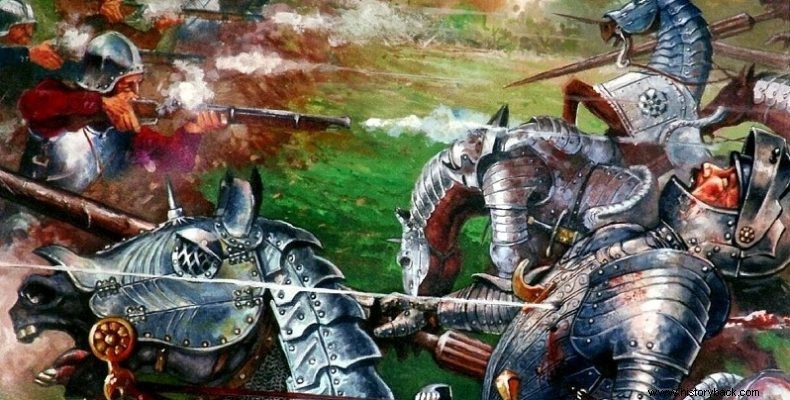
Handheld firearms had been invented years before. They had been used in various battles of the early Renaissance. However, they were not the decisive instrument of the fight, unlike the heavily armored lance-wielding horsemen and the masses of sarissaphores. But everything changed from April 28, 1503.
Cerinola is a town in southern Italy not far from Bari. In 1502, another war had broken out in Italy, which, historically, is part of the long series of conflicts that have gone down in history as the Italian Wars j. Spain having conquered southern Italy was at war with France. The Spanish king had sent to Italy one of the best generals of the time and the famous "great king" Gonzalo de Cordoba – who also acted in Greece against the Turks.
The great general, however, lacked the basic tool of dominance, a strong army. His king had endowed him with only 6,300 men of which 700 heavy cavalry, 800 light cavalry, 4,000 infantry and the other gunners and auxiliaries, with 20 light, mainly cannons. On the other hand the French king sent against the Spaniards a force numerically superior, but above all qualitatively superior, including 630 of the famous noble French "knights" Gendarms .
The first battle of the new war was fought at Seminary where the French were defeated. But it was a minor tactical conflict. Instead the upcoming battle at Cerinola would prove more important. De Córdoba had the great talent to be able to distinguish the value of the land and he takes advantage of it perfectly. Thus he discerned the tactical importance of the Cerinola hills and retreated there, proceeding to organize the terrain at a time when heroic raids by heavy cavalry and phalanx sarissaphoros were considered the best recipe for victory.
The Spanish army also included in its ranks German infantrymen (the famous Landsknecht ) while the Spanish infantry was organized in "colunelles" (=phalanxes), i.e. mixed infantry formations made up of sarrissobers, arquebusiers and "rondeleros » shield-bearing swordsmen. de Córdoba ordered his men to dig a trench which formed the first line of his defensive position in which 1,000 arquebusiers lined up. Pointed stakes were also placed in the ground in order to prevent the advance of the terrible Gendarms.
Behind the arquebusiers the sarrissophores and the rondeleros were lined up, while on top of the hills the artillery was lined up to have a perfect view and be able to hit the enemy in the advance phase. The Spanish heavy cavalry were in reserve, while the mounted Spanish light cavalry lined up in front of the arquebusier trench, covering it from the view of their opponents.
The French commander Louis d'Armagnac, Count of Guise, was an imbued with chivalric ideals a young man of 31, descended from the house of d'Anjou. Brave to the point of stupidity, he was not distinguished for his tactical skills. So as soon as he saw the enemy arrayed against them, he ordered an immediate attack upon them without even waiting for his artillery, which played no part in the battle.
Put in charge of the Gendarms charged against the enemies. The zinettes immediately withdrew allowing the arquebusiers to begin reaping with their fire , the French. De Guise was not disappointed, however, and launched a new attack with the same tragic result. Then de Guise attempted to outflank the Spanish right, but his horsemen fell into the Spanish traps and retreating again received the deadly fire of the arquebusiers. Then de Guise was killed.
Headless the French horsemen retreated. Then the head of the Swiss, Tabien Sadier, undertook to continue the attack, in the same stupid way. de Córdoba decided to take advantage of the stupidity of his opponents and withdrew the arquebusiers from the front line, deploying them, in two bodies on the flanks, while he threw his Germans against the Swiss. The Swiss advanced unmolested, but as they engaged the Germans in a deadly fight with the sarissas, the arquebusiers leaned inland and began to mow them down, literally, striking at the sides of their phalanx. The rest of the French infantry tried to help but were unable to do so under threat from the Spanish infantry as well. And when Sadier was killed, the Swiss began to retreat.
Seeing the enemy retreat, de Córdoba ordered a general counterattack. The French panicked and fled. Only the Swiss retreated in an organized manner, despite the losses they were taking. The defeated retreated, abandoning most of their guns. The victors had a total of 500 dead and wounded. Conversely the blood toll on the other side was heavy. The dead alone exceeded 4,000 thousand. Thousands were still wounded and captured. de Córdoba ordered that fallen enemies and friends be buried with honor and in a Christian manner. The Battle of Cerinola was the first battle in history to be decided by fire and not iron.

